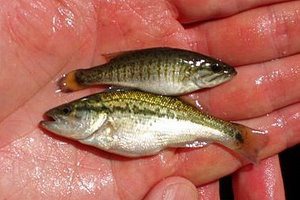The smallmouth bass is a very popular game fish in some areas. Several organizations, newsletters, and guiding services are devoted solely or primarily to fishing for this species.
Photo Credit: Geoffrey A. Hammerson
Micropterus dolomieu
Common Name: smallmouth bass
Other Common Names: black bass, brown bass, green bass
Animal Guild: Fish
Class > Order > Family: Teleostei > Perciformes > Centrarchidae
What does the species look like?
The elongate body is compressed from side to side, the upper jaw does not extend beyond the rear edge of the eye in adults, the dorsal fin (located on back) has two parts that are fairly broadly connected (front part has 9-10 spines, rear part has 13-15 (usually 14) soft rays), and the shortest spine is more than half as long as the longest spine. The sides have irregular dark vertical markings, the cheeks have dark streaks that radiate from eye or snout, and a white spot is present at the rear end of the gill cover white spot may be surrounded by darker coloration or less obviously by lighter colors). This species never has a broad black stripe on each side. The tail fin of young is three-banded with yellow, black, and white (at the tip); this fades with age. Maximum total length is around 27.5 inches (69 cm).
Where is the species found?
States & Provinces
AB, AL, AR, AZ, BC, CA, CO, CT, DE, GA, IA, ID, IL, IN, KS, KY, MA, MB, MD, ME, MI, MN, MO, MS, MT, NB, NC, ND, NE, NH, NJ, NM, NS, NV, NY, OH, OK, ON, OR, PA, QC, RI, SC, SD, SK, TN, TX, UT, VA, VT, WA, WI, WV, WY
Distribution
Smallmouth bass is native to the St. Lawrence-Great Lakes, Hudson Bay (Red River), and Mississippi River basins from southern Quebec to North Dakota and south to northern Alabama and eastern Oklahoma. It has been widely introduced throughout the United States, southern Canada, and other countries.
Smallmouth bass prefer large clear lakes (especially in the northern part of the range) and clear mid-order streams with many large pools, abundant cover (rocks, shelves, logs, etc.), and cool summer temperatures.
General Phenology and Life History
In the warmer months, smallmouth bass are most active at dusk and dawn. In the northern part of the range, they are relatively inactive in winter. Spawning habitat includes shallow water in lakes or quiet areas of streams, often fairly close to shore or downstream of a structure. Lake populations may move a short distance up a stream to spawn. Females deposit eggs in nests made by males, usually near cover on gravel or sand bottoms. Nests are solitary rather than colonial. Spawning occurs in late spring or early summer and may be interrupted by flooding. Eggs hatch in about 2-10 days. Males guards eggs and hatchlings. Fry leave the nest about 10-15 days after egg deposition.
Which phenophases should I observe?
Do you see/hear...?
Activity
Adults in freshwater More...
For abundance, enter the number of individual animals observed in this phenophase.
Adults feeding For abundance, enter the number of individual animals observed in this phenophase.
Development
Dead or dying adults For abundance, enter the number of individual animals observed in this phenophase.
Method
Individuals on a hook For abundance, enter the number of individual animals observed in this phenophase.
Individuals in a net For abundance, enter the number of individual animals observed in this phenophase.
What do these phenophases look like?
There is currently no photoguide available for this species. If you'd like help us create one, use the guidance document and species template provided here . Then send it via email to education@usanpn.org when it is complete.
